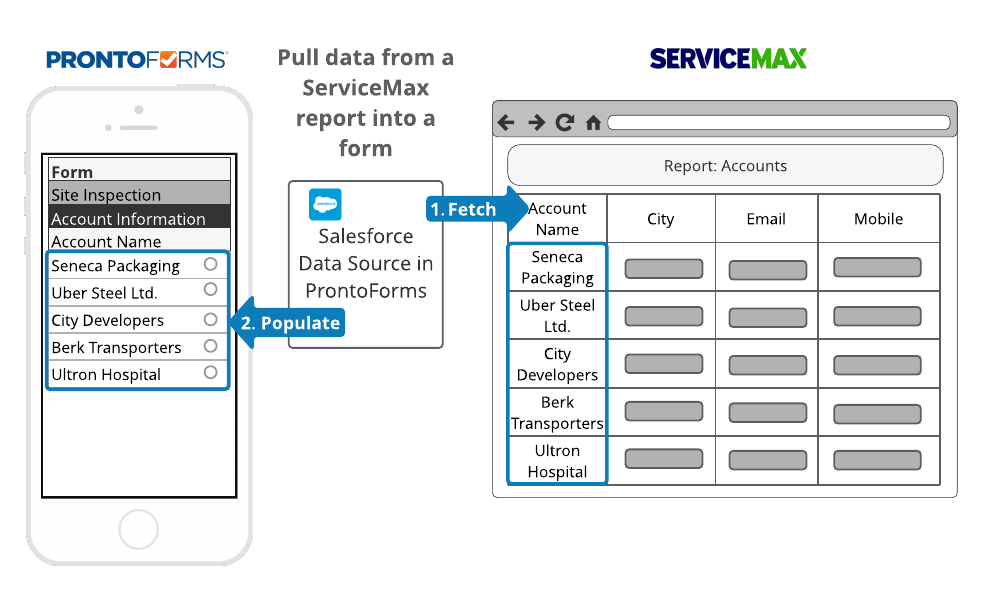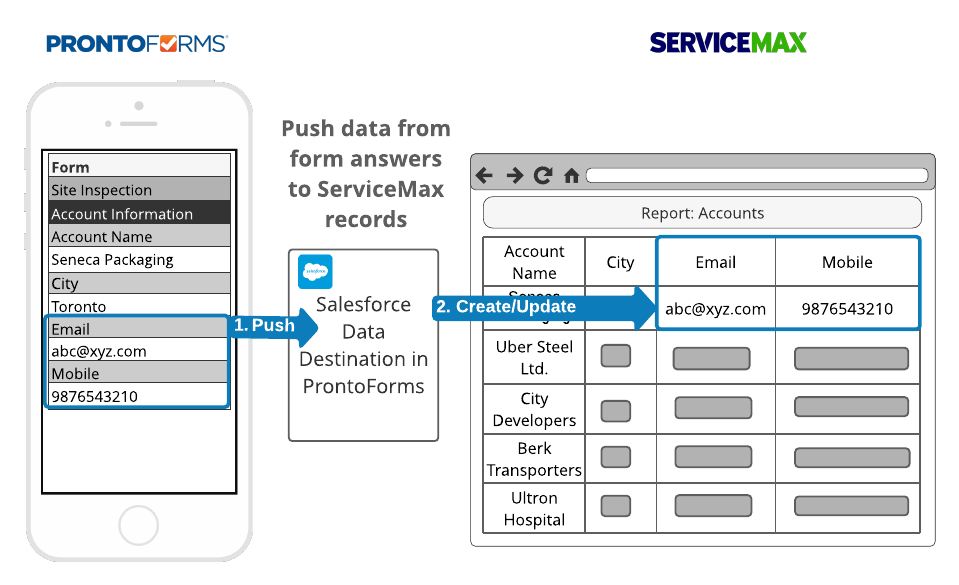How the ServiceMax Integration Works
The ServiceMax integration uses a Salesforce Data Source![]() Data sources, also known as "Lookups", are external sources of data that you upload or connect to TrueContext. You can reference this data in a form to populate answers or answer options. Data sources save typing, reduce errors, and make it easy to provide mobile users with only the relevant, most current data., Salesforce Data Destination
Data sources, also known as "Lookups", are external sources of data that you upload or connect to TrueContext. You can reference this data in a form to populate answers or answer options. Data sources save typing, reduce errors, and make it easy to provide mobile users with only the relevant, most current data., Salesforce Data Destination![]() A Data Destination specifies where to send data from a submitted form. You can use Data Destinations to automate data sharing and storage, routing data to a specific service (such as email or cloud storage) in several different formats., and App‑to‑App communication to exchange data between TrueContext and ServiceMax. This topic briefly describes how the integration works.
A Data Destination specifies where to send data from a submitted form. You can use Data Destinations to automate data sharing and storage, routing data to a specific service (such as email or cloud storage) in several different formats., and App‑to‑App communication to exchange data between TrueContext and ServiceMax. This topic briefly describes how the integration works.
Available on the Advanced and Enterprise tiers:
Pull data from the ServiceMax org
If you want to automatically populate a form with data from ServiceMax, set up a Salesforce Data Source in TrueContext.
For example, you might have a list of customer names, customer contacts, and customer equipment specifications stored in your ServiceMax account. You can use this data in TrueContext to
-
populate the answer choices for a Dropdown, Multiselect, or Radio Button question, and
-
prefill the answers to certain questions based on the previous responses.
The following illustration shows an example of how a TrueContext Data Source pulls Account Names from ServiceMax into a form.

Push data to the ServiceMax org
If you want the submitted form data to update existing records or create new records in ServiceMax, set up a Salesforce Data Destination in TrueContext.
For example, your front-line workers enter customer data such as city, email address, and mobile number in TrueContext. You can use this data to update or create records in ServiceMax to keep customer information up-to-date.
The following illustration shows an example of how TrueContext pushes data to ServiceMax.

Exchange data between apps
Inbound requests
The TrueContext Mobile App can receive a “request” or “call” from another app on the same device (the source app). An inbound App‑to‑App request directs the TrueContext Mobile App to launch in the foreground and complete an action. For example, the ServiceMax app can direct the TrueContext Mobile App to:
- Open a new form and prepopulate it with data from the ServiceMax app.
- Open a list of forms in the user’s Inbox.
- Search for previously submitted forms.
- Open a resource document or image in the Resource Library
 The Resource Library enables you to build a digital, multilingual, and searchable knowledge base that contains your organization’s essential content. Available to your mobile users in the Mobile App, the Resource Library simplifies the distribution, discovery, and use of critical information—such as manuals and schematics—to support your field technicians in their work..
The Resource Library enables you to build a digital, multilingual, and searchable knowledge base that contains your organization’s essential content. Available to your mobile users in the Mobile App, the Resource Library simplifies the distribution, discovery, and use of critical information—such as manuals and schematics—to support your field technicians in their work..
Callbacks
-
Your ServiceMax app must be configured to handle the callbacks and any data returned. You might need to check with your own experts to set this up for your specific app.
-
We recommend that you configure a custom App‑to‑App allow list to manage the apps that can receive data from the TrueContext Mobile App.
-
App‑to‑App callbacks are supported on the Advanced and Enterprise tiers only.
If you want the mobile device user to stay in the TrueContext Mobile App, you don’t need to specify a callback parameter.
Tip:Organizations that use a work order management system can combine the offline functionality of App‑to‑App communication with the online functionality of a TrueContext cloud-based Data Destination. A Data Destination is typically used to send detailed data to the back-office system of the ServiceMax app. Data Destinations![]() A Data Destination specifies where to send data from a submitted form. You can use Data Destinations to automate data sharing and storage, routing data to a specific service (such as email or cloud storage) in several different formats. enable full access to the data submitted from the TrueContext Mobile App, including photos.
A Data Destination specifies where to send data from a submitted form. You can use Data Destinations to automate data sharing and storage, routing data to a specific service (such as email or cloud storage) in several different formats. enable full access to the data submitted from the TrueContext Mobile App, including photos.
